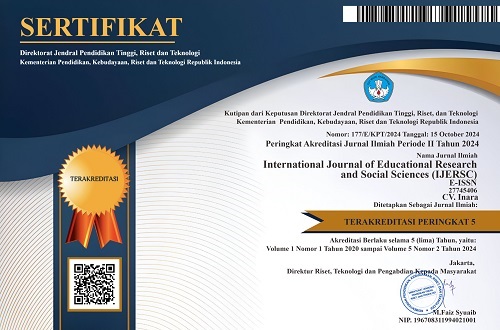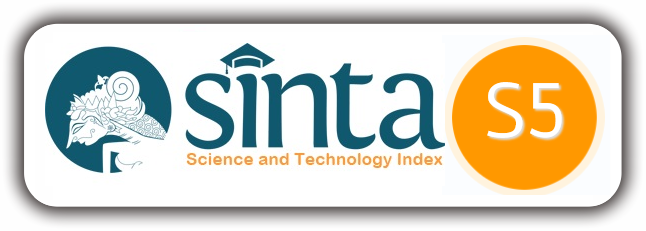Critical Thinking in Da'wah: Bridging Text and Context
DOI:
https://doi.org/10.51601/ijersc.v6i2.910Abstract
This study aims to analyze the urgency and implementation of critical thinking in modern Islamic preaching as a bridge between text and context. The research method used is library research by examining relevant scientific sources in the form of national and international journal articles, academic books, and empirical research results. Data analysis was carried out thematically through a content analysis approach and supported by bibliometric visualization using VOSviewer for 150 related articles. The results of the study show that critical thinking is the main pillar in developing adaptive contextual preaching in the digital era. Bibliometric visualization shows that critical thinking is the main node that is closely connected to the theme of digital preaching, religious moderation, and prevention of radicalism. The implementation of critical thinking in preaching includes evaluative abilities towards sources of teachings, contextual awareness of the audience, dialogical openness, and ethical reflection in responding to differences. The strategy for strengthening implementation includes reformulating the dai education curriculum, digital media literacy training, and developing interactive discussion forums based on scientific arguments. This study emphasizes that strengthening critical attitudes in da'wah is an epistemological need to produce moderate, solution-oriented da'wah messages that are relevant to the dynamics of the times.
Downloads
References
. Alatas, SH (2006). Islamic Thought and the Challenges of the Times. Jakarta: LP3ES.
. Arifin, B. (2011). The Science of Islamic Communication. Jakarta: Raja Grafindo Persada.
. Azra, A. (2004). The Origins of Islamic Reformism in Southeast Asia. Crows Nest: Allen & Unwin.
. Esposito, J.L., & Kalin, I. (Eds.). (2011). Islamophobia: The Challenge of Pluralism in the 21st Century. Oxford University Press.https://doi.org/10.1093/acprof:osobl/9780199792916.001.0001
. Facione, P. A. (2011). Critical thinking: What it is and why it counts. Insight Assessment. https://doi.org/10.13140/RG.2.1.1846.0245
. Fealy, G., & White, S. (Eds.). (2008). Expressing Islam: Religious Life and Politics in Indonesia. Institute of Southeast Asian Studies. https://doi.org/10.1355/9789812308760.
. Fathurrahman, F., Irawan, A. ., & Fridayanti, Sri . (2023). Effectiveness Of Regional Regulation Number 20 Of 2001 Regarding Regulation Of Street Traders And Seasonal Street Traders In Tarakan City. International Journal of Educational Research &Amp; Social Sciences, 4(3), 429–434. https://doi.org/10.51601/ijersc.v4i3.652.
. Sulaiman, S., Halim Soebahar, A. ., & Mundir, M. (2023). Madrassa Diniyah Curriculum Transformation In Pesantren: A Study Of Wali Songo Mimbaan And Salafiyah Syafi'iyah Sukorejo Pesantren In Situbondo. International Journal of Educational Research &Amp; Social Sciences, 4(3), 444–453. https://doi.org/10.51601/ijersc.v4i3.659.
. Mutiara Cipta, D. ., & Alvin, S. (2023). Safeguarding Personal Information: Communication Privacy Management By Gen-Z Influencers. International Journal of Educational Research &Amp; Social Sciences, 4(3), 465–471. https://doi.org/10.51601/ijersc.v4i3.653.
. Mohammad Solekhan, Kunarto, & Mahmuda Pancawisma Febriharini. (2022). Forest and Land Fire Management Strategies: Prevention and Law Enforcement. International Journal of Educational Research &Amp; Social Sciences, 3(2), 567–580. https://doi.org/10.51601/ijersc.v3i2.306.
. D. Yuliana Sinaga. (2022). The Effect Of Ralistic Mathematics Learning Model And Project-Based Learning Model On Problem Solving Ability And Motivation Of Students In Class V Private Elementary School Markus Medan Helvetia. International Journal of Educational Research &Amp; Social Sciences, 3(2), 590–600. https://doi.org/10.51601/ijersc.v3i2.268.
. Nugroho, A. . (2022). Principle of Balance of Relationship Between Banks and Customers in Mudharabah Agreements. International Journal of Educational Research &Amp; Social Sciences, 3(2), 645–652. https://doi.org/10.51601/ijersc.v3i2.325.
. Halpern, D.F. (2014). Thought and knowledge: An introduction to critical thinking (5th ed.). Psychology Press. https://doi.org/10.4324/9781315885390
. Hasan, N. (2020). Textual rigidity and the decline of religious tolerance: A study of the Salafi da'wah movement in Indonesia. Studia Islamika, 27(3), 453–477. https://doi.org/10.15408/sdi.v27i3.16501
. Hoffman, L. H., & Moe, W. W. (2022). Digital religion: Understanding religious practice in the digital age. Journal of Communication, 72(3), 345–366. https://doi.org/10.1093/joc/jqac005
. Kurniawan, A., Rahman, F., & Yusuf, M. (2022). The relationship between preacher's critical thinking ability and da'wah message effectiveness in social media. Journal of Islamic Studies and Humanities, 7(2), 95–110. https://doi.org/10.21580/jish.2022.7.2.10245
. Littlejohn, S. W., & Foss, K. A. (2010). Theories of Human Communication (10th ed.). Waveland Press.
. Mustofa, I. (2020). The implementation of critical thinking in da'wah: A study among Indonesian university students. Qudus International Journal of Islamic Studies, 8(1), 45–60. https://doi.org/10.21043/qijis.v8i1.6789
. Nasution, A., & Wahid, A. (2021). Strengthening critical thinking for preachers in digital da'wah: Preventing hate speech and radicalism. Journal of Islamic Communication, 5(2), 110–123. https://doi.org/10.24042/jic.v5i2.9000
. Paul, R., & Elder, L. (2014). Critical Thinking: Tools for Taking Charge of Your Professional and Personal Life (2nd ed.). Pearson Education.
. Said, M., Rahman, A., & Syahrir. (2023). Critical thinking and moderate da'wah: The basis for tolerance in Indonesian Islamic preaching. Al-Jami'ah: Journal of Islamic Studies, 61(1), 79–104. https://doi.org/10.14421/ajis.2023.611.79-104
. Setiawan, A., & Yusof, N.M. (2021). Contextual da'wah and critical thinking: Promoting social harmony in multicultural society. Journal of Da'wah Studies, 4(2), 120–135. https://doi.org/10.24239/jds.v4i2.7121
. Wood, J. T. (2020). Communication Mosaics: An Introduction to the Field of Communication (8th ed.). Cengage Learning.
. Zed, M. (2004). Library Research Methods. Jakarta: Yayasan Obor Indonesia.
Downloads
Published
How to Cite
Issue
Section
License
Copyright (c) 2025 International Journal of Educational Research & Social Sciences

This work is licensed under a Creative Commons Attribution 4.0 International License.






















